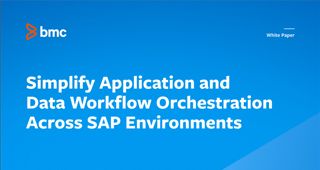Having an effective enterprise resource planning (ERP) system is essential to the management of core business processes. Rightfully referred to as the central nervous system of an enterprise, an ERP system contains much—or all—of a business’s data and provides a single source of truth. SAP® ERP Central Component (ECC) has been one of the most popular ERPs on the market since its release in 2006.
Companies across multiple industries rely on SAP ECC to manage their core processes and keep their business running. However, SAP has begun to shift focus to its newest ERP platform, SAP S/4HANA, a cloud-based ERP system with built-in intelligent technologies, including artificial intelligence (AI), machine learning (ML), and advanced analytics.
In 2020, SAP announced that it would provide minimal mainstream support of ECC until 2027. After that, the price to maintain it would increase until 2030, when SAP would discontinue maintenance altogether. That leaves the businesses that rely on SAP ECC with a critical decision to ponder in the intervening years: when and how to move to S/4HANA.
Making the Move
Why would businesses with established ERPs want to go through the trouble of migrating to something new? SAP isn’t pushing its current customers to migrate for nothing. The move to S/HANA will provide enterprises with many benefits because it:
- Ensures higher quality data
- Reduces shadow IT
- Improves customer satisfaction
- Delivers better data insights and predictive analysis
- Streamlines business processes
That said, migrating to a new ERP system, especially moving from on-premises to cloud, poses a serious challenge for a lot of businesses. With so many of a company’s vital functions relying on the established ERP, the requirements of a migration can feel overwhelming. When contemplating the move to S/4HANA, companies are faced with some worrying questions, such as:
- What are the hardware, software, and licensing requirements involved in migration?
- How much will migration cost?
- How much time, and which resources, will be needed to train current employees or hire people with the required skillsets?
The list of considerations goes on and on. Clearly, the move from SAP ECC to S/4HANA requires extensive planning. A company must start by assessing its current landscape to better understand the path forward. It also has to evaluate its data archiving strategy, or lack thereof. Without data archiving, companies will likely face serious costs to migrate their data into SAP S/4HANA.
Companies also need to determine how many enhancements and interfaces they currently have, particularly the amount of custom coding they are using. The more custom coding they have, the more performance issues they might encounter and the more costs they will accrue as they migrate. And finally, companies must choose the cloud provider that best fits their unique requirements.
Once all that is done, they can choose their migration path. Although each path is different, the choice comes down to three possible migration strategies:
Greenfield approach—new implementation
The company builds a new SAP S/4HANA implementation from the ground up. This approach allows the business to implement the latest processes and configurations and customize the ERP to fit its needs. It should also be noted that choosing a greenfield approach means losing historical data and configurations that might be preferred or required.
Brownfield approach—system conversion
The company converts its existing SAP ECC system to S/4HANA, maintaining the structure that is already in place and optimizing where necessary. Brownfield is the most popular migration path because it doesn’t require companies to part with their custom ERP system, historical data, and current configurations.
Hybrid approach
The company migrates selected data and configurations to SAP S/4HANA. This gives businesses with complex system landscapes the ability to keep what they need, add any required upgrades, and consolidate where necessary.
Control-M for SAP®
Regardless of the amount of planning and work a business does, migrating to SAP S/4HANA comes with many big decisions and significant challenges, especially if a business has a well-established ERP. Despite the possible benefits, the effort required and potential risks associated with migration can make companies hesitant to take the leap. Control-M for SAP can help ease and even accelerate the path to migration.
SAP-certified for S/4HANA, Control-M streamlines and automates all jobs, interceptions, scheduling, and monitoring. That allows IT operations (ITOps) teams to maximize their current SAP investment while redeploying critical resources to prepare for migration. With Control-M for SAP, companies can reduce the time, complexity, and specialized knowledge required for their SAP environment, saving resources and eliminating process and data portability risks.
On the business side, that means:
- Streamlined business processes
- Better data insights and predictive analysis
- Higher customer satisfaction
- Reduced audit risk
- Effective user role and profile management
- Advanced security and governance
- And much more
If you’re ready to make the move to S/4HANA, Control-M can help. Read our white paper, Simplify Application and Data Workflow Orchestration Across SAP Environments, to learn more.







